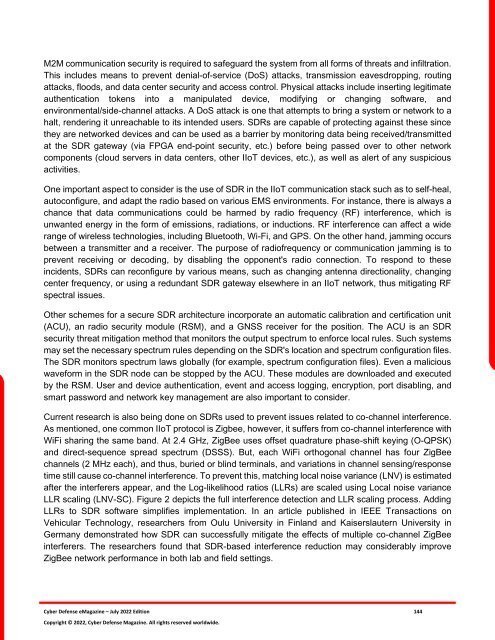Cyber Defense eMagazine July Edition for 2022
Cyber Defense eMagazine July Edition for 2022 #CDM #CYBERDEFENSEMAG @CyberDefenseMag by @Miliefsky a world-renowned cyber security expert and the Publisher of Cyber Defense Magazine as part of the Cyber Defense Media Group as well as Yan Ross, Editor-in-Chief and many more writers, partners and supporters who make this an awesome publication! Thank you all and to our readers! OSINT ROCKS! #CDM #CDMG #OSINT #CYBERSECURITY #INFOSEC #BEST #PRACTICES #TIPS #TECHNIQUES
Cyber Defense eMagazine July Edition for 2022 #CDM #CYBERDEFENSEMAG @CyberDefenseMag by @Miliefsky a world-renowned cyber security expert and the Publisher of Cyber Defense Magazine as part of the Cyber Defense Media Group as well as Yan Ross, Editor-in-Chief and many more writers, partners and supporters who make this an awesome publication! Thank you all and to our readers! OSINT ROCKS! #CDM #CDMG #OSINT #CYBERSECURITY #INFOSEC #BEST #PRACTICES #TIPS #TECHNIQUES
You also want an ePaper? Increase the reach of your titles
YUMPU automatically turns print PDFs into web optimized ePapers that Google loves.
M2M communication security is required to safeguard the system from all <strong>for</strong>ms of threats and infiltration.<br />
This includes means to prevent denial-of-service (DoS) attacks, transmission eavesdropping, routing<br />
attacks, floods, and data center security and access control. Physical attacks include inserting legitimate<br />
authentication tokens into a manipulated device, modifying or changing software, and<br />
environmental/side-channel attacks. A DoS attack is one that attempts to bring a system or network to a<br />
halt, rendering it unreachable to its intended users. SDRs are capable of protecting against these since<br />
they are networked devices and can be used as a barrier by monitoring data being received/transmitted<br />
at the SDR gateway (via FPGA end-point security, etc.) be<strong>for</strong>e being passed over to other network<br />
components (cloud servers in data centers, other IIoT devices, etc.), as well as alert of any suspicious<br />
activities.<br />
One important aspect to consider is the use of SDR in the IIoT communication stack such as to self-heal,<br />
autoconfigure, and adapt the radio based on various EMS environments. For instance, there is always a<br />
chance that data communications could be harmed by radio frequency (RF) interference, which is<br />
unwanted energy in the <strong>for</strong>m of emissions, radiations, or inductions. RF interference can affect a wide<br />
range of wireless technologies, including Bluetooth, Wi-Fi, and GPS. On the other hand, jamming occurs<br />
between a transmitter and a receiver. The purpose of radiofrequency or communication jamming is to<br />
prevent receiving or decoding, by disabling the opponent's radio connection. To respond to these<br />
incidents, SDRs can reconfigure by various means, such as changing antenna directionality, changing<br />
center frequency, or using a redundant SDR gateway elsewhere in an IIoT network, thus mitigating RF<br />
spectral issues.<br />
Other schemes <strong>for</strong> a secure SDR architecture incorporate an automatic calibration and certification unit<br />
(ACU), an radio security module (RSM), and a GNSS receiver <strong>for</strong> the position. The ACU is an SDR<br />
security threat mitigation method that monitors the output spectrum to en<strong>for</strong>ce local rules. Such systems<br />
may set the necessary spectrum rules depending on the SDR's location and spectrum configuration files.<br />
The SDR monitors spectrum laws globally (<strong>for</strong> example, spectrum configuration files). Even a malicious<br />
wave<strong>for</strong>m in the SDR node can be stopped by the ACU. These modules are downloaded and executed<br />
by the RSM. User and device authentication, event and access logging, encryption, port disabling, and<br />
smart password and network key management are also important to consider.<br />
Current research is also being done on SDRs used to prevent issues related to co-channel interference.<br />
As mentioned, one common IIoT protocol is Zigbee, however, it suffers from co-channel interference with<br />
WiFi sharing the same band. At 2.4 GHz, ZigBee uses offset quadrature phase-shift keying (O-QPSK)<br />
and direct-sequence spread spectrum (DSSS). But, each WiFi orthogonal channel has four ZigBee<br />
channels (2 MHz each), and thus, buried or blind terminals, and variations in channel sensing/response<br />
time still cause co-channel interference. To prevent this, matching local noise variance (LNV) is estimated<br />
after the interferers appear, and the Log-likelihood ratios (LLRs) are scaled using Local noise variance<br />
LLR scaling (LNV-SC). Figure 2 depicts the full interference detection and LLR scaling process. Adding<br />
LLRs to SDR software simplifies implementation. In an article published in IEEE Transactions on<br />
Vehicular Technology, researchers from Oulu University in Finland and Kaiserslautern University in<br />
Germany demonstrated how SDR can successfully mitigate the effects of multiple co-channel ZigBee<br />
interferers. The researchers found that SDR-based interference reduction may considerably improve<br />
ZigBee network per<strong>for</strong>mance in both lab and field settings.<br />
<strong>Cyber</strong> <strong>Defense</strong> <strong>eMagazine</strong> – <strong>July</strong> <strong>2022</strong> <strong>Edition</strong> 144<br />
Copyright © <strong>2022</strong>, <strong>Cyber</strong> <strong>Defense</strong> Magazine. All rights reserved worldwide.


















